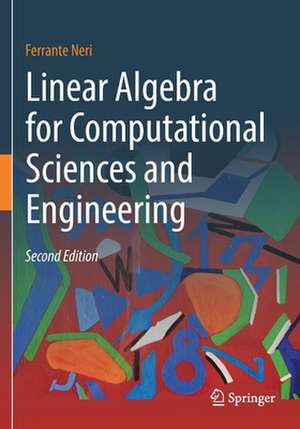Linear Algebra for Computational Sciences and Engineering
Autor Ferrante Nerien Limba Engleză Paperback – 13 aug 2020
This book presents the main concepts of linear algebra from the viewpoint of applied scientists such as computer scientists and engineers, without compromising on mathematical rigor. Based on the idea that computational scientists and engineers need, in both research and professional life, an understanding of theoretical concepts of mathematics in order to be able to propose research advances and innovative solutions, every concept is thoroughly introduced and is accompanied by its informal interpretation. Furthermore, most of the theorems included are first rigorously proved and then shown in practice by a numerical example. When appropriate, topics are presented also by means of pseudocodes, thus highlighting the computer implementation of algebraic theory.
It is structured to be accessible to everybody, from students of pure mathematics who are approaching algebra for the first time to researchers and graduate students in applied sciences who needa theoretical manual of algebra to successfully perform their research. Most importantly, this book is designed to be ideal for both theoretical and practical minds and to offer to both alternative and complementary perspectives to study and understand linear algebra.
| Toate formatele și edițiile | Preț | Express |
|---|---|---|
| Paperback (1) | 496.99 lei 6-8 săpt. | |
| Springer International Publishing – 13 aug 2020 | 496.99 lei 6-8 săpt. | |
| Hardback (1) | 675.83 lei 6-8 săpt. | |
| Springer International Publishing – 12 aug 2019 | 675.83 lei 6-8 săpt. |
Preț: 496.99 lei
Preț vechi: 621.23 lei
-20% Nou
Puncte Express: 745
Preț estimativ în valută:
95.11€ • 98.93$ • 78.52£
95.11€ • 98.93$ • 78.52£
Carte tipărită la comandă
Livrare economică 15-29 aprilie
Preluare comenzi: 021 569.72.76
Specificații
ISBN-13: 9783030213237
ISBN-10: 3030213234
Pagini: 574
Ilustrații: XXV, 574 p. 169 illus., 5 illus. in color.
Dimensiuni: 178 x 254 x 36 mm
Greutate: 1.03 kg
Ediția:2nd ed. 2019
Editura: Springer International Publishing
Colecția Springer
Locul publicării:Cham, Switzerland
ISBN-10: 3030213234
Pagini: 574
Ilustrații: XXV, 574 p. 169 illus., 5 illus. in color.
Dimensiuni: 178 x 254 x 36 mm
Greutate: 1.03 kg
Ediția:2nd ed. 2019
Editura: Springer International Publishing
Colecția Springer
Locul publicării:Cham, Switzerland
Cuprins
1. Basic Mathematical Thinking.- 2. Matrices.- 3. Systems of Linear Equations.- 4. Geometric Vectors.- 5. Complex Numbers and Polynomials.- 6. An Introduction to Geometric Algebra and Conics.- 7. An Overview of Algebraic Structures.- 8. Vector Spaces.- 9. An Introduction to Inner Product Spaces: Euclidean Spaces.- 10. Linear Mappings.- 11. An Introduction to Computational Complexity.- 12. Graph Theory.- 13. Applied Linear Algebra: Electrical Networks.- A. non-linear Algebra: An Introduction to Boolean Algebra.- Proofs of Theorems that Require Further Knowledge of Mathematics.- Appendix. Solutions to the Exercises.
Recenzii
“The book is well written, structured, and very intuitive. Every concept is thoroughly introduced and theorems are rigorously proved. Definitions and proofs are explained in a clear and friendly way.” (Ctirad Matonoha, zbMATH 1442.15001, 2020)
Notă biografică
Ferrante Neri received a Master's degree and a PhD in Electrical Engineering from the Technical University of Bari, Italy, in 2002 and 2007 respectively. In 2007, he also received a PhD in Scientific Computing and Optimization from University of Jyväskylä, Finland. From the latter institution, he received the DSc degree in Computational Intelligence in 2010. He was appointed Assistant Professor at the Department of Mathematical Information Technology at the University of Jyväskylä, Finland in 2007, and in 2009 as a Research Fellow with Academy of Finland. Dr Neri moved to De Montfort University, United Kingdom in 2012, where he was appointed Reader in Computational Intelligence and in 2013, promoted to Full Professor of Computational Intelligence Optimisation. Since 2019 Ferrante Neri moved to the School of Computer Science, University of Nottingham, United Kingdom. Ferrante Neri’s teaching expertise lies in mathematics for computer science. He has a specific long lasting experience in teaching linear and abstract algebra. His research interests include algorithmics, hybrid heuristic-exact optimisation, scalability in optimisation and large scale problems.
Textul de pe ultima copertă
This book presents the main concepts of linear algebra from the viewpoint of applied scientists such as computer scientists and engineers, without compromising on mathematical rigor. Based on the idea that computational scientists and engineers need, in both research and professional life, an understanding of theoretical concepts of mathematics in order to be able to propose research advances and innovative solutions, every concept is thoroughly introduced and is accompanied by its informal interpretation. Furthermore, most of the theorems included are first rigorously proved and then shown in practice by a numerical example. When appropriate, topics are presented also by means of pseudocodes, thus highlighting the computer implementation of algebraic theory.
It is structured to be accessible to everybody, from students of pure mathematics who are approaching algebra for the first time to researchers and graduate students in applied sciences who needa theoretical manual of algebra to successfully perform their research. Most importantly, this book is designed to be ideal for both theoretical and practical minds and to offer to both alternative and complementary perspectives to study and understand linear algebra.
Caracteristici
Second Edition contains over 150 pages of new material, including theory, illustrations, pseudocodes and examples throughout. Includes new information on matrices, vector spaces and linear mapping. Covers all aspects of linear algebra from the perspective of computational science and engineering Provides both a technical approach and an informal interpretation of mathematics Includes examples with definitions and theorems, as well as end-of-chapter exercises with solutions Presents a chapter where the study of an electrical network is shown as an algebraic exercise
